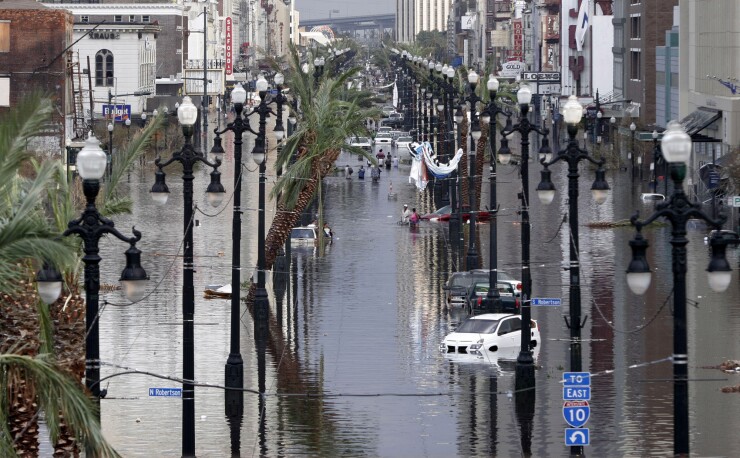(Bloomberg) --When Hurricane Katrina slammed into New Orleans in August 2005, causing greater insurance losses than any other natural disaster in history, it became clear that a lot of the city's flood protection engineering — walls, pumps, levees — had failed.
Something else failed, too: Insurers' catastrophe models.
The models at the time overestimated the strength of the levees. They also underestimated the exposure of commercial properties. And they didn't fully account for storm surge. It was the storm surge — amplified by huge wind-driven waves — that drowned New Orleans.
"Katrina was a very tricky storm," said Karen Clark, co-founder and chief executive of Karen Clark & Co., a catastrophe modeling firm in Boston. "The storm surge turned out to be a lot more impactful than the models had assumed for a Category 3 hurricane."
Today, nearly 20 years after Katrina, the financial stakes from hurricane hits have risen dramatically. Thousands of people have moved to the coast and built homes that are a lot more expensive to repair or replace, a development that's been exacerbated by the effects of inflation.
"What we build today is not what we built 10 or 20 years ago," said Clark, one of the pioneers of catastrophe modeling. "It's now three-car garages and five marble bathrooms."
The other X factor is climate change. Swiss Re Institute says that
"Hurricane Katrina does not represent a worst-case tropical cyclone loss scenario," the institute warned in a recent report. "Some of the North Atlantic hurricanes that occurred during [the] early 20th century, if they were to strike today, would cause insured losses well above $100 billion in 2024 prices."
Today's catastrophe models are undeniably more powerful, thanks to the increase in computing power, the greater availability of granular asset-level data, and
But significant blind spots remain, especially when it comes to hazards like tornadoes, hailstorms and floods. These so-called secondary perils are causing greater losses but are also harder to model compared to "peak" perils like hurricanes or earthquakes.
Last year, Hurricane Helene tore through the US southeast, causing unprecedented inland flooding and landslides, even in elevated areas such as Asheville, North Carolina.
"The disconnect between [catastrophe] models and the reality of Helene's destruction raises significant concerns, as many models fail when the environment shifts in ways that historical data cannot account for," Jencap, a wholesale insurance broker,
Many homeowners hadn't bought flood insurance because they weren't in an official flood-risk zone. Insurers, meanwhile, weren't offering widespread coverage because it was hard to calculate the risk at the level of individual properties.
"It's kind of a Catch-22, because if insurers don't have good models to price the risk, they won't write it," said Clark. At the same time, "in vulnerable areas it's expensive so people won't buy it."
Ultimately, even a robust theoretical model is only as good as the data that feeds it. When Katrina swept through New Orleans, insurers could count on "replacement cost" estimates for residential properties, which they used to calculate the risk exposure. But equivalent estimates for commercial properties were "woefully inadequate," says Clark, partly because the locations weren't coded correctly and the values were understated.
That gap still exists — and it could deliver a nasty surprise to insurers and their corporate clients, should another Katrina-like catastrophe occur.
"The biggest issue with getting accurate loss estimates on commercial properties is the inadequacy of the exposure data being provided to the models," said Clark. "It's astounding how poor the quality is. The problem is if the values go up then the losses and likely the premiums go up."
To contact the author of this story:
Gautam Naik in London at






